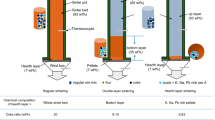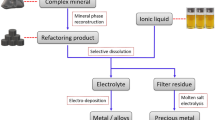Abstract
The present study concerns the chemical–physical and electrochemical characterisations of the pale green surfaces formed on outdoor bronzes exposed in urban conditions. In the first part, results from investigations performed on the equestrian statue of the French king Louis XIV exposed in the Palace of Versailles (France) are given. Analyses by energy-dispersive spectrometry and Raman spectroscopy, coupled with scanning electron microscopy, show that the external layer is characterised by a marked selective dissolution of copper and zinc of the alloy leading to an important relative enrichment in tin compounds. The same phenomenon with the same magnitude, determined from dissolution factors fCu and fZn, has also been evidenced on other bronze monuments used for comparison. Proportionality between the amount of dissolved copper and zinc cations to their respective initial content in the alloy is evidenced independently of the tin content. The pale green patina appears to be a complex mixture of copper and tin compounds whose structure still needs to be more precisely characterised. In the second part, the electrochemical reactivity of tin compound enriched patina was investigated by cyclic voltammetry from a Cu10Sn electrode in sulfate solution at pH=2 and 5.6. This patina is stable at pH 5.6 but reactive at pH 2 in relation to the modification of properties of tin species in the patina. Mott–Schottky application in pH 5.6 solution revealed that the bronze patina exhibits two types of semiconducting properties according to the potential domains, similar to what has been observed for pure tin in aqueous solutions. The destabilisation of bronze patinas in outdoor conditions and consequently the cyclic erosion due to rainfall have been attributed to the modification of tin species properties rather than to the transformation of copper compounds.
Similar content being viewed by others
References
L. Robbiola, L.-P. Hurtel, Mém. Etud. Sci. Rev. Métall. 88, 809 (1991)
A.G. Nord, K. Tronner, J. Boyce, Water Air Soil Pollut. 127, 293 (2001)
V. Hayez, J. Guillaume, A. Hubin, H. Terryn, J. Raman Spectrosc. 35, 732 (2004)
G.P. Cicileo, M.A. Crespo, B.M. Rosales, Corros. Sci. 46, 929 (2004)
C. Chiavari, K. Rahmouni, H. Takenouti, S. Joiret, P. Vermaut, L. Robbiola, Electrochim. Acta 52, 7760 (2007)
X. Zhang, W. He, I. Odnevall Wallinder, J. Pan, C. Leygraf, Corros. Sci. 44, 2131 (2002)
A. Krätshmer, I. Odnevall Wallinder, C. Leygraf, Corros. Sci. 44, 425 (2002)
A. Lins, T. Power, in Ancient & Historic Metals – Conservation and Scientific Research, ed. by D.A. Scott, J. Podany, B.B. Considine (The Getty Conservation Institute, 1995), pp. 119–151
M. Wadsak, T. Aastrup, I. Odnevall Wallinder, C. Leygraf, M. Schreiner, Corros. Sci. 44, 791 (2002)
C. Kleber, M. Schreiner, Appl. Surf. Sci. 45, 2851 (2003)
P. Picciochi, A.C. Ramos, M.H. Mendonça, I.T.E. Fonseca, J. Appl. Electrochem. 34, 989 (2004)
L. Morselli, E. Bernardi, C. Chiavari, G. Brunoro, Appl. Phys. A 79, 363 (2004)
E. Sidot, N. Souissi, L. Bousselmi, E. Triki, L. Robbiola, Corros. Sci. 48, 2241 (2006)
K. Rahmouni, S. Joiret, L. Robbiola, A. Srihri, H. Takenouti, V. Vivier, Bulg. Chem. Commun. 1, 26 (2005)
L. Robbiola, C. Fiaud, S. Pennec, in ICOM Committee for Conservation, 10th triennial meeting, Washington DC, vol. II (James & James, 1993), preprints, pp. 796–802
M.J. Hughes, M.R. Cowell, P.T. Craddock, Archaeometry 18, 19 (1976)
E. Sidot, A. Kahn-Harari, E. Cesari, L. Robbiola, Mater. Sci. Eng. A 393, 147 (2005)
K. Nassau, A.E. Miller, T.E. Gradedel, Corros. Sci. 27, 703 (1987)
L. Robbiola, J.-M. Blengino, C. Fiaud, Corros. Sci. 40, 2083 (1998)
V. Hayez, Use of Micro-Raman Spectroscopy for the Study of the Atmospheric Corrosion of Copper Alloys of Cultural Heritage, Ph.D. thesis, Vrije Universiteit Brussel, Bruxelles (2006), p. 384
R. Edwards, R.D. Gillard, P.A. Williams, Mineral. Mag. 60, 427 (1996)
M. Metikos-Hukovic, S. Omanovic, A. Jukic, Electrochim. Acta 45, 977 (1999)
D.R. Lide (ed.-in-chief), Handbook of Chemistry and Physics, 87th edn. (2006–2007)
G.M. Ingo, L. Giorgi, N. Zachhetti, N. Azzerri, Corros. Sci. 33, 361 (1992)
Author information
Authors and Affiliations
Corresponding author
Additional information
PACS
07.78.+s; 81.05.-t; 81.15.-z; 81.65.Kn
Rights and permissions
About this article
Cite this article
Robbiola, L., Rahmouni, K., Chiavari, C. et al. New insight into the nature and properties of pale green surfaces of outdoor bronze monuments. Appl. Phys. A 92, 161–169 (2008). https://doi.org/10.1007/s00339-008-4468-4
Received:
Accepted:
Published:
Issue Date:
DOI: https://doi.org/10.1007/s00339-008-4468-4




